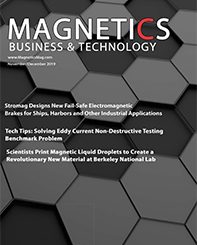By Stan Trout | Spontaneous Materials
This is the second blog in a series, describing the many types of mistakes made with permanent magnets. Again, my intent is to help engineers in the future avoid the mistakes made in the past, and not to embarrass anyone.
Everyone’s experience is different, so please feel free to add your insights in the comments section below.
The second group of mistakes on my list are:
- Failing to protect from corrosion
- Failing to optimize the design to use the least amount of material
The issue of corrosion tends to come up with NdFeB magnets. Our friends who make and use ferrite magnets can relax here. Since their product is already fully oxidized, it seems unlikely that any further chemical reaction is possible, under normal operating conditions. Occasionally corrosion comes up with samarium cobalt or alnico, but it is usually not as great a concern.
At Magnetics 2004, I made a presentation about the corrosion of sintered NdFeB magnets.[1] It recounted some of the history and cures that people have applied to the subject of corrosion. In the early days of NdFeB corrosion was a huge problem because people were not doing their homework on the subject. At first, we were all somewhat tone deaf about corrosion. However, over time the compositions of the alloys have gradually changed to reduce the tendency to oxidize and the coating used are now superior to what we had before. Today many people use double or triple coatings, such as nickel with copper, to provide the optimum protection. This “belt and suspenders” approach is good practice in demanding applications, because it does not take much of a pinhole in a coating to allow a tiny hydrogen atom from dissociated water to penetrate the coating and start the corrosion process.
As long as engineers consider corrosion early in the design process and do the proper evaluating and confirming tests of the coatings, they are likely to be OK with their project.
As Ronald Reagan said, “trust but verify.” We need to be vigilant about corrosion.
Magnetic design is a difficult process. The fundamental math is onerous, even for people who are relatively good mathematicians. Today there are have many excellent software packages to help us design magnetic circuits. But they cost money, normally involve a significant learning curve and often require some mathematical sophistication to obtain the maximum benefit.
Someone designing a magnetic device for the first time has a few basic choices on how to proceed.
- They can find a good existing design and duplicate it.
- They can purchase a software package and take time to learn it.
- They can hire a consultant who specializes in magnetic circuit design.
- Or they can simply try a variety of magnets: different materials and different dimensions, until they find something that works satisfactorily.
Depending on the situation, any of the first three above approaches may make sense. For something relatively simple, the first approach may work. If the project is a bit unusual and unique, the third approach may be fine. And finally, if you want to be in the design business, then you really should buy the software and devote an employee or two to mastering it; that’s the second approach.
But occasionally we run into people who have used the fourth approach. By the time they have found me, they are usually frustrated, and with good reason. The fundamental truth they have discovered is that there are typically many possible magnetic solutions. In other words, there isn’t just a single unique solution to any magnetic design problem. Solutions found by trial and error often use substantially more magnet material than is actually necessary to do the job, with a corresponding increase in magnet cost. Such a magnetic design is very wasteful. So when raw material prices shoot up, as they did for rare earths a few years ago, people who used the “cut and try” approach to design find themselves at a very clear disadvantage compared to their competitors who have used any of the other approaches. In addition, often it is too late in the design cycle to make any changes. Much to their chagrin, they realize that they have locked themselves into a poor and uncompetitive design.
Our recommendation is to use one of the first three methods described above to design magnetic devices and be sure that your design is optimized to use the minimum amount of material. Do not design by trial and error.
Four down, thirteen to go.
[1] www.spontaneousmaterials.com/Papers/CorrosionPresentation.pdf
www.spontaneousmaterials.com/Papers/Corrosion.pdf
 About the Author
About the Author
Dr. Stan Trout has more than 35 years’ experience in the permanent magnet and rare earth industries. Dr. Trout has a B.S. in Physics from Lafayette College and a Ph.D. in Metallurgy and Materials Science from the University of Pennsylvania. Stan is a contributing columnist for Magnetics Business & Technology magazine. Spontaneous Materials, his consultancy, provides practical solutions in magnetic materials, the rare earths, technical training and technical writing. He can be reached at strout@ieee.org.



